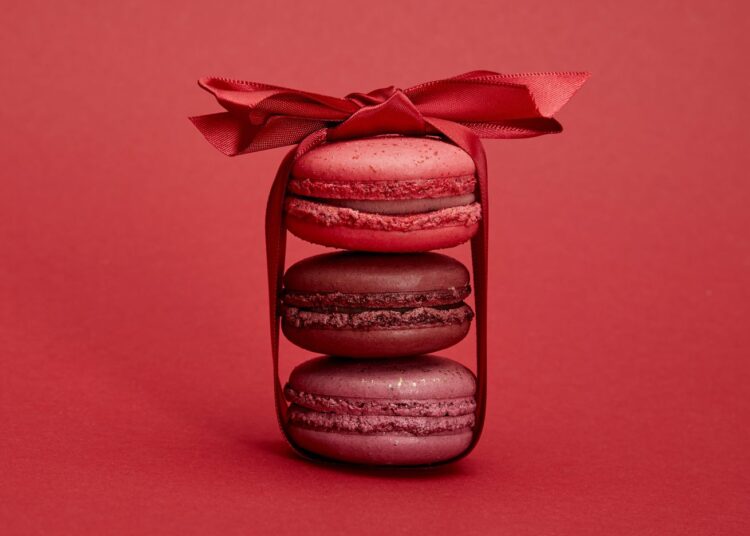Shutterstock
In 2023, the dinner table went coquette
It was undeniably the year of the bow. Heavily influenced by designer Sandy Liang, bows hung off braided hair, clothes, and bags, in an impossible-to-miss mainstreaming of the “coquette” aesthetic. And given how much the worlds of food and fashion have enmeshed recently, it was inevitable that this bow fixation would extend onto the dinner table, both in terms of tablescapes and the food on them.
This year, food stylists and creators used bows to tie together rings of bread and encircle ice cream cones. They wrapped around baguettes, dangled off cakes, and adorned pastries. (Many of these bows were inedible, but not all.) Ribbons dripped down candelabras and were painted on expensive plates. The concept certainly isn’t new though: The food artist Jamie Bernstein has been playing with bows and food since at least 2019.
While those examples existed mostly in earnest, coquette food is ending the year on a more ridiculous note. In a TikTok trend, people are putting bows everywhere, including: around ice in a glass, a tamale, pickles in a jar, and a spread of Raising Cane’s. With the videos set to Lana del Rey’s “Let the Light In,” the trend nods to a kind of “self-aware” hyperfemininity, one participant told the New York Times. Coquette food has even gone corporate: Jollibee posted its rendition on Instagram, pink bows tied around Chickenjoy drumsticks.
That bows are cute is their obvious appeal. On food, the fact that a bow is extraneous matters, says Moya Luckett, a media historian whose expertise includes fashion and femininity. “It adds to that moment of a feeling that you’re being treated,” she says. This is especially true when a bow is inedible, she adds: Extraneous touches suggest the privilege of extra time or resources.
For some food artists and stylists, there is also a statement to be made in the bow’s embrace of girlishness and whimsy, and of adding a final, frivolous touch to a piece of food. Bows appear both edible and inedible in the work of Austria-based cake and multimedia artist Sophia Stolz. Guided by a love of opulence, Stolz cites fashion and femininity as major inspirations. Bows, which she uses to dramatic effect, “make everything very elegant and kind of fragile,” Stolz says.
Artist Lina Sun Park’s work with bows and food — often bows and bread, specifically — also predates this year’s trend, though it’s frequently employed as an example of it. A photograph of hers, of a croissant with a baby blue bow, accompanied a September New York Magazine feature about the “bow tax” in luxury fashion. Her sliced bread stitched with pink ribbon is bait for sharing in Instagram stories, and Park once captioned one of these “bread studies” as “the feminine urge to sew a piece of ribbon through bread.”
Tongue in cheek though that may be, there’s also an earnestness to the sentiment. Both sliced bread and bows are things that Park liked as a child and learned to dislike with age, she explains; the bread seemed too processed, the bows too saccharine. Putting them together in her work now reflects a new relationship to old comforts. “I’ve been back to loving bows again for some time now,” Park says. “I think there has always been a bit of a taboo to being too feminine, too ‘cute.’ However, as I get older, and my likes stay more constant, I don’t deprive myself anymore or hold myself to these rules; I’m more indulgent.”
The idea of reclaiming girlhood and the debate as to whether it can simply be fun and flippant, or if it’s inherently regressive or infantilizing, has underscored this entire year. This coquette food is a tiny piece of the so-called “Year of the Girl.” It is a year that also gave us “girl dinner,” around which that same critique also played out. To opt into girlhood is a sign of a bigger cultural problem, to some: In The Cut, Isabel Cristo classifies this year of “girl everything” as marked by a willful ignorance and a naive desire to “opt-out” of adult womanhood, with its challenges.
But as that creator told the New York Times, there is a self-awareness in these increasing applications of bows on food, even if some iterations on the concept are less satirical than they are sincere attempts to make food feel special or to tap into personal nostalgia. Luckett classifies the broader bow moment as representing an “ironic femininity, where you’re sort of playing up at being the good girl, but there’s also either an edge or a sense of performance.”
Coquette food is a performance that understands its own perception. Is a spread of Taco Bell truly made any more “girly” by the addition of a bow? Only as much as it matters to you. As Claire Marie Healy wrote in Dirt last year, the coquette aesthetic is often misinterpreted: “To be a coquette was never a seduction, after all, but a trick.” That analysis extends to the coquette corn dog.














